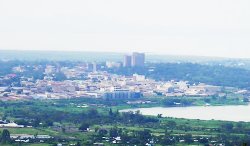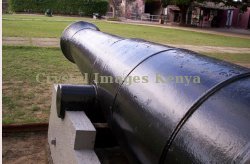 |
|||||
|
|
 |
 |
 |
 |
 |
|
HISTORY
1920 - 1963: Building the Colony  In 1901, the railway had reached Lake Victoria at Port Florence (now Kisumu).
 The Portuguese had conquered the East African coast in the 16th century. They built Fort Jesus in Mombasa (above). The Omani Arabs later defeated the Portuguese and took over Fort Jesus until the arrival of the British in the 19th century.
|
KENYA AS A BRITISH COLONY1884 – 1920: Origins of the Kenyan stateKenya wasn’t meant to happen. The birth and growth of Kenya as a state is one of those historical turns of fate that take up a life of their own, taking the limelight away from the original purpose for their invention. It was the 19th century; Africa was being explored in expeditions sponsored by powerful organizations in Europe, such as the Royal Geographic Society and the Church Missionary Society (CMS). Information got back to Europe of a land rich in minerals, timber, fertile land and teeming with strange-looking wildlife such as gorillas which were first called “wild men”. European nations which had missed out on the conquests of America all wanted a piece of Africa. The British had already staked a claim to the East coast of Africa with its ancient Afro-Arabic port cities of Lamu, Malindi, Mombasa, Pemba and Zanzibar. The Sultan of Zanzibar was pressurized into abolishing slavery and afterwards his entire territories became British protectorates. In the geopolitical language of the 19th century, a protectorate was a land where a foreign power wanted to preclude other powers from laying a claim to such territory before establishing an administrative structure. In this case, the Sultan of Zanzibar would continue ruling over his dominions but no other foreign power could engage in hostile military activity for or against him because he had acquired British “protection”. After discovering the source of the Nile as Lake Victoria, the British wanted control over the lake region too. The Nile is extremely important to Sudan and Egypt, both of which were British territories and it had been a geopolitical strategy to find and control the river’s source as well. However, there existed the powerful African kingdom of Buganda right at the point where the waters of Lake Victoria spilt over the Owen Falls to become the Nile. Rather than engage in combat, the British opted to work with the Kabaka (Buganda King) and also offered him protection. By the early
1880’s, Africa was full of protectorates and territories all
claimed by various European powers. There was increasing anxiety that
the scramble for land in Africa could instigate war in Europe. A
conference was held in Berlin, Germany where representatives of those
European states interested in Africa negotiated and drew the
territorial boundaries that define African states to this day. Now that the British claim to Buganda was no longer in dispute, there was the desire to ease transportation with Britain for purposes of trade and military mobility. Up until this time, the only access to Buganda was by ox caravan from Mombasa, a journey that could take months through jungle, deserts and steep valleys. A proposal was floated for construction of a railway and telegraph line into the interior from Mombasa port. Work on the railway began in 1895 after much debate in the British parliament over the viability of this expensive venture. By the economics of the time, the Buganda railway was going to be a costly, technically challenging affair to be undertaken in a largely unknown land teeming with warlike tribes such as the Maasai. However the desire to claim the source of the Nile overrode such concerns. In 1901, the railway had reached Lake Victoria at Port Florence (now Kisumu). Another twist in history emerged: for the railway to function, its security had to be guaranteed against attacks by foreign powers or hostile tribes. The Berlin Conference gave the Tanganyika territory (now Tanzania) to Germany. In most places along the Buganda railway, Tanganyika was less than 200km away. All the land along the railway line, from Mombasa to the Rift Valley became the British East Africa Protectorate. The protectorate extended from Mt Kilimanjaro in the south to Ethiopia in the north. The eastern borders of the British East Africa Protectorate met Italian Somaliland at the port of Kismayu on the Indian Ocean. With the western borders of British East Africa along the Rift Valley, all territories extending westwards were administered from Uganda. Operations on the railway began soon after its completion. The Uganda railway gave rise to almost all of Kenya’s major towns, including the capital city of Nairobi. By 1901, Nairobi was a tin and wood outpost in the bush teeming with wildlife, soldiers, tribes people and labourers imported from India to work on the railway. There was also plenty of plague and cholera which caused the deaths of many and, at one time, forced authorities to burn the entire outpost to the ground. The growth of Nairobi accelerated even further when the site was chosen as the administrative headquarters of British East Africa. Meanwhile, tribes which had initially been hostile to the railway had been subdued either through punitive raids or by negotiated terms. Negotiations with Maasai leaders were the last major obstacle towards the long term security for the railway. It also granted the British access to vast lands suitable for settlement. Church missionaries had already experimented with coffee, tea, cotton, sugar and other crops. It had been discovered that these crops could do extremely well in the territory’s land and climate. With the existing railway infrastructure available for exports, commercial farming was a definite possibility. Back home, the British encouraged its citizens to settle in East Africa with promises of abundant, fertile land at very attractive terms including leases running for 999 years. The first to take up the offer were members of the British nobility, eager to make a name and a fortune for themselves in what was considered frontier territory. In spite of initial setbacks for the settlers attributable to inexperience with local climate, many of them did succeed in achieving a respectable standard of living which would have been difficult in the U.K. The Great War of 1914 – 1918 extended to East Africa between the British and the Germans in Tanganyika. The German military strategy was to divert British forces from Europe by extending the war to the African territories. German naval ships disrupted British supplies to India and East Africa on the Indian Ocean, using Tanganyika as a base. Land based units sneaked into British East Africa attempting to sabotage the Uganda Railway. Battles were fought on land after settlers in British territory came together to form a militia. Africans were also recruited and trained to play supporting roles in the battlefield. With time, the threat on land was eliminated but shipping on the Indian Ocean was under attack by German warships, especially the “Konigsberg”. This warship was much feared by sailors and had acquired an awesome reputation for invincibility at sea. The British dispatched a secret mission to Tanganyika to strike the Konigsberg and were successful in sinking the ship as it took shelter in the Rufiji Delta. That marked the defeat of the Germans on the Indian Ocean front. The victorious British encouraged even more settlement in Kenya after the war. There no longer existed the possibility of rebellion by African tribes, consequently settler numbers grew, the agricultural economy flourished and towns sprouted all over the interior mostly along the railway lines. Missionaries were actively preaching Christianity to Africans and opening schools in the process. A small class of educated Africans was beginning to emerge. Expeditions by wild game hunters created a foundation for future tourism. The need for greater administration of politics, security and the economy arose after British authorities in London realized that their East African territory was a potential goldmine. In 1920, the British East Africa protectorate became the “Kenya Colony”, named after the massive snow-peaked mountain lying at the geographical centre of the territory. |
©2007 Godfrey M.
Kimega
Crystal Images
Kenya, Email: [email protected]